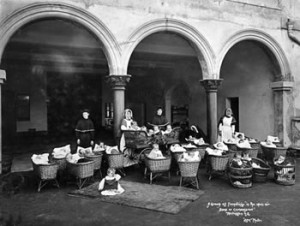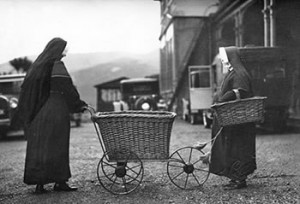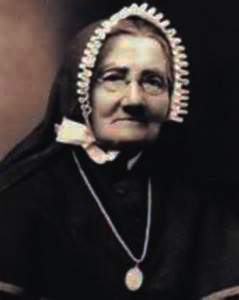“A Down-under Spirituality” – Mother Suzanne Aubert
Homily Preached at the Chapel of the Sisters of Compassion
for Federation of Catholic Bishops’ Conferences of Oceania.
The history of the Church can be told in many ways. I think the most beautiful, would be a history of our spiritualties. What could be more inspiring than the panorama, the kaleidoscope, of the Holy Spirit’s work, entering into our human history through the charisms of remarkable people and those who have followed them? That’s what has brought us here today from around fifteen nations to this beautiful chapel.
There is no single pattern or template of the Holy Spirit’s work. But if there is one word that might sum up, in the wake of Pentecost, the Acts of the Apostles surely it is dynamism: in both what occurred historically; and in what is spawned in us - readers of this sacred text - who then strive to invigorate our life of discipleship.
In the passage read today we hear of a scattering: a scattering that, notwithstanding its origin in persecution, brings about a multiplication of affirmation, of mission. This dynamic outbreak appears first as a matter of geography – they went beyond the land of Israel into Syria and Cyprus; but it is also an outbreak of meta noia, a change in mind, in vision, daring to imagine a new possibility: gentiles and pagans, too, could be delivered the good news and believe.
Into that mix steps Barnabas. What a figure; so often overlooked. The encourager, the one schooled in the wisdom and reasonableness of the moderate Sanhedrin leader, Gamaliel, the one who gave Saul a break, a new beginning. How forgiving, merciful, wise, and also courageous and trusting must Barnabas have been. Little wonder we are told that he was “good”, and “filled with the Holy Spirit and faith” (Acts 11:23). Free of the clamp of prejudice, or closed thinking, or any spirit of revenge, Barnabas released the passion within the newly converted Paul. As Pope Francis has put it: stifling inertia can only be healed by breathing in the pure air of the Holy Spirit who frees us from all that robs us of the Gospel (cf. Evangelii Gaudium, 97).
For dynamic mission, as well as the imagination, geography does remain significant. Geography is the playing field of History. For many of our scattered communities of Oceania, there is a common launching point of the delivery of our faith: France and in particular Lyon. What an explosive dynamism there was in that Church, notwithstanding its persecution in the wake of the French Revolution (1789-1799; 1848), spawning generosity and courage, new thinking and vision, new sodalities and Religious Orders, and waves of missionaries setting forth across the seas.
Into that mix jumped Suzanne Aubert. One thing that has struck me about her leap of faith, is the springboard. By that I mean the parish from which she came, the parish which nurtured her as a girl, a teenager and young woman: Saint Nizier. Among, what we might today call, the young adults group of that one parish was Francoise Perroton, missionary to Futuna, Philippe Viard, the first Bishop of Wellington, Claudine Thevenet, the Foundress of the Sisters of Jesus and Mary, and Frederic Ozanam, founder of the St Vincent de Paul society, though he didn’t grow up in the parish, was married there in his 20s. They all, with Suzanne, left an enduring, recognised vitality within the church universally but let us not forget the ordinary parishioners of Saint Nizier. If we were to pick up a copy of their parish magazine of the 1840s this is what we would find listed under parish programmes and activates: hospices, dispensaries, soup kitchens, factory workshops, homes for special needs children, orphanages, old peoples care, and homes for girls at risk. This vibrancy of the perhaps unsung life of a parish community of faith is what made Suzanne Aubert; these good works were the world of her mother and grandmother; and riding their current, as it were, she was delivered to New Zealand on Sunday 30th December 1860 aged 25; and the first hand extended to her, as she disembarked at Auckland harbour, was Maori.
This is not the occasion to outline a chronology of her works here in New Zealand, nor can I claim to have any particular expertise in the spirituality of the Sisters of Compassion for whom Suzanne is foundress, but I do wish to share just a few glimpses of the hue that she has contributed to the Church’s universal panorama of spiritual treasures.

Mother Aubert (centre right)
and several Sisters of Compassion supervise children getting fresh air and sunshine outside
the Home of Compassion in Island Bay, Wellington, in 1908.
The parish activities of Saint Nizier, meeting the social needs of society still reeling from the aftershocks of the French revolution, amounted to a practical Christianity which easily transposed both to the Maori people of Aotearoa and the pioneer settler life in New Zealand. A DIY - do it yourself – mentality sits strongly in the pragmatic culture of this country. Within that milieu Suzanne thrived. With a budget of virtually nothing this savvy and creative young French woman was happy to raise funds through teaching French, music and sewing to the daughters of the well-to-do. But that was not her mission. Her work with and among Maori was her most enduring thread partially through education but particularly through simple companionship of families. Though comfortable in the homes of MPs, doctors, and businessmen Mother Aubert was herself most at home on horseback, in a canoe, pruning the orchard, caring for children and the sick, or concocting herbal medicines in her famed shed.
The only thing of her ever described as unorthodox was her initiative. I am not exactly sure what that might mean but perhaps this is an example: to a great but ailing Maori Missioner whom I hasten to add she respected fondly, her compatriot Marist Father Antoine Seon, she administered electric shock treatment. Heaven only knows what form that took in 1873! Anyhow, she described him after her experiment as being ‘much more mobile’. Running for his life perhaps.
I am not going to quote the Constitutions. Suffice to say an out and out truly apostolic order came forth, brimming with a dynamic practical Christian witness, and let us thank God that Archbishop Redwood with a Barnabian spirit gave Mother Mary Joseph his full encouragement. The Constitutions from the hand of Suzanne were more chatty than prescriptive but at times her penchant for detail wins: our convents, she wrote, should have a doormat inside and outside, a bootscraper! A more “down-under” spiritualty than that I find hard to imagine.

The Sisters with their
iconic ‘begging pram’ were a regular sight on the cobbled streets of Wellington for many years
Let me conclude with Mother Aubert’s own words. Far from being a social worker in a habit, she was very clear about the distinction between secular philanthropy and Christian charity, as love for God expressed in service of others. In her words: “to love God above all things, to give ones heart and soul, mind and strength, in order to make others better and happier: that is life, that is happiness justice and truth”.
To the Sisters of Compassion present here we again say thank you for your welcome and most especially – in the words of today’s gospel, which encapsulate so succinctly your spirit – thank you for your works that are your witness (cf. Jn 10: 25).
Amen.
+ Charles Drennan
Bishop of Palmerston North


 Entries(RSS)
Entries(RSS)